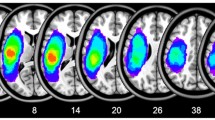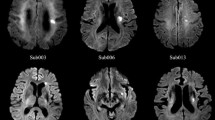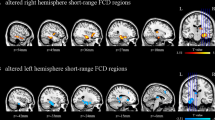Abstract
To explore the brain default mode network (DMN) in patients with motor aphasia resulting from cerebral infarction, we used resting state functional magnetic resonance imaging (fMRI) to investigate the possible neural mechanism. Thirteen patients with motor aphasia resulting from cerebral infarction and ten matched controls were selected in this study. All subjects were examined using resting state fMRI. We chose the posterior cingulate cortex as the region of interest and then used functional connectivity analysis to calculate the DMN functional connectivity and analyze differences in the functional connectivity between the two groups. Compared with normal controls, aphasia patient group showed a significantly decreased functional connectivity in bilateral medial frontal gyrus, superior frontal gyrus, middle frontal gyrus, middle temporal gyrus, precuneus and cuneus. The aphasia patient group showed increased functional connectivity mainly in bilateral medial frontal gyrus, middle frontal gyrus, inferior frontal gyrus, precentral gyrus, insula. The DMN in cerebral infarction motor aphasia patients showed significantly decreased functional connectivity in the resting state. The DMN most likely plays an important role in motor aphasia resulting from cerebral infarction. Furthermore, functional connectivity in the brain regions surrounding the left and right Broca’s areas was significantly enhanced due to compensatory mechanisms. This may be helpful for the recovery of language function in cerebral infarction patients with motor aphasia.



Similar content being viewed by others
References
Raichle ME, Macleod AM, Snyder AZ et al (2001) A default mode of brain function. Proc Natl Acad Sci USA 98:676–682
Broyd SJ, Demanuele C, Debener S et al (2009) Default-mode brain dysfunction in mental disorders: a systematic review. Neurosci Biobehav Rev 33:279–296
Fransson P (2005) Spontaneous low-frequency BOLD signal fluctuations: an fMRI investigation of the resting-state default mode of brain function hypothesis. Hum Brain Mapp 26:15–29
Greicius MD, Krasnow B, Reiss AL et al (2003) Functional connectivity in the resting brain: a network analysis of the default mode hypothesis. Proc Natl Acad Sci USA 100:253–258
Leech R, Braqa R, Sharp DJ (2012) Echoes of the brain within the posterior cingulate cortex. J Neurosci 32:215–222
Buckner RL, Vincent JL (2007) Unrest at rest: default activity and spontaneous network correlations. NeuroImage 37:1091–1096
De Luca M, Benckmann CF, De Stefano N et al (2006) fMRI resting state networks define distinct modes of long-distance interactions in the human brain. NeuroImage 29:1359–1367
Breier JI, Castillo EM, Boake C et al (2004) Spatiotemporal patterns of language-specific brain activity in patients with chronic aphasia after stroke using magnetoencephalography. NeuroImage 23:1308–1316
Abo M, Senoo A, Watanabe S et al (2004) Language related brain function during word repetition in post-stroke aphasics. Neuro Report 15:1891–1894
Jones SE, Mahmoud SY, Phillips MD (2011) A practical clinical method to quantify language lateralization in fMRI using whole-brain analysis. NeuroImage 54:2937–2949
Schlaug G, Marchina S, Norton A (2008) From singing to speaking: why singing may lead to recovery of expressive language function in patients with Broca’s Aphasia. Music Percept 25:315–323
Li K, Jin Z, Zhang L et al (2012) Functional MRI study of the Broca aphasia after cerebral stoke. J Chin Med Imag 23:153–156 (in Chinese)
Perani D, Cappa SF, Tettamanti M et al (2003) A fMRI study of word retrieval in aphasia. Brain Lang 85:357–368
Rosen HJ, Petersen SE, Linenweber MR et al (2003) Neural correlates of recovery from aphasia after damage to left inferior frontal cortex. Neurology 55:1883–1894
Coelho C, Lê K, Mozeiko J et al (2012) Discourse production following injury to the dorsolateral prefrontal cortex. Neuropsychologia 50:3564–3572
Sergeant JA, Geurts H, Oosterlaan J (2002) How specific is a deficit of executive functioning for attention-deficit/hyperactivity disorder. Behav Brain Res 130:3–28
Baddeley Alan, Sala Sergio Della (1996) Working memory and executive control. Philos Trans Bio Sci 351:1397–1404
Perner J, Lang B (1999) Development of theory of mind and executive control. Trends Cogn Sci 3:337–344
Cavanna AE, Trimble MR (2006) The precuneus: a review of its functional anatomy and behavioural correlates. Brain 129:564–583
Schwartz MF, Kimberg DY, Walker GM et al (2009) Anterior temporal involvement in semantic word retrieval: voxel-based lesion-symptom mapping evidence from aphasia. Brain 132:3411–3427
Sharp DJ, Scott SK, Wise RJ (2004) Retrieving meaning after temporal lobe infarction: the role of the basal language area. Ann Neurol 56:836–846
Ward AM, Schultz AP, Huijbers W et al (2014) The parahippocampal gyrus links the default-mode cortical network with the medial temporal lobe memory system. Hum Brain Mapp 35:1061–1073
Squire LR, Zola-Morgan S (1991) The medial temporal lobe memory system. Science 253:1380–1386
Zhang XL, Kazuhisa N, Luo J (2008) Hippocampus’s role in forming “task-related” associations: Flashing to the things you are looking for. Chin Sci Bull 53:2496–2505
Middleton FA, Strick PL (2000) Basal ganglia and cerebellar loops: motor and cognitive circuits. Brain Res Rev 31:236–250
Marien P, Baillieux H, De Smet HJ et al (2009) Cognitive, linguistic and affective disturbances following a right superior cerebellar artery infarction: a case study. Cortex 45:527–536
Conflict of interest
The authors declare that they have no conflict of interest.
Author information
Authors and Affiliations
Corresponding author
About this article
Cite this article
Wang, X., Wang, M., Wang, W. et al. Resting state brain default network in patients with motor aphasia resulting from cerebral infarction. Chin. Sci. Bull. 59, 4069–4076 (2014). https://doi.org/10.1007/s11434-014-0491-3
Received:
Accepted:
Published:
Issue Date:
DOI: https://doi.org/10.1007/s11434-014-0491-3




